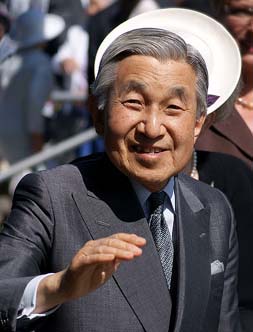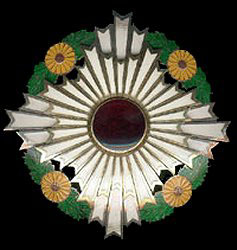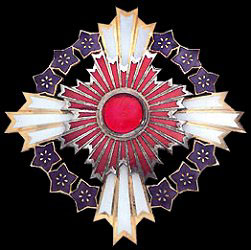
H.I.M. Emperor Akihito of Japan
天皇 明仁
Japan

H.I.M. Emperor Akihito of
Japan
天皇
明仁
Grand Master of
Supreme Order of the
Chrysanthemum 大勲位菊花章 -
Established: 1876 by Emperor
Meiji of Japan
The Supreme Order of the Chrysanthemum (大勲位菊花章
daikun'i kikkashō, literally Grand Order of the Badge of the
Chrysanthemums) is Japan's highest order. The Grand Cordon of the Order was
established in 1876 by Emperor Meiji of Japan; the collar of the Order was added
on January 4, 1888. Although technically the order has only one class, it can
either be awarded with collar (or chain), or with grand cordon (or
sash). Unlike its European counterparts, the order may be conferred
posthumously.
The collar of the order is awarded only posthumously, except for the reigning emperor, who automatically holds the rank. Exceptions are made for foreign heads of state, who can be awarded the collar as a sign of friendship.
The grand cordon is the highest possible honor a Japanese citizen could be awarded during his lifetime. Aside from the imperial household, only three grand cordons have been awarded to living citizens and eleven to the deceased.
The badge of the order is a four-pointed gilt badge with white enameled rays; the center bears a red enameled sun disc. On each of the four corners of the badge there is a yellow-enameled chrysanthemum blossom with green enameled chrysanthemum leaves. The badge is suspended on a yellow-enameled chrysanthemum, either on the collar or on the grand cordon.


Order of the Paulownia Flower
- Established: 1888
The Order of the Paulownia Flowers (桐花章
Tōka shō) is an order presented by the Japanese
Government. Established in 1888 during the Meiji Restoration as the highest
award in the Order of the Rising Sun; however, since 2003 it has been an Order
in its own right.. The only grade of the order is Grand Cordon of the Order
of the Paulownia Flowers (旭日桐花大綬章
Kyokujitsu tōka daijushō), which ranks higher than the
Order of the Rising Sun but lower than the Order of the Chrysanthemum.
The badge for the Order is a gilt cross with white enameled rays, bearing a central emblem of a red enameled sun disc surrounded by red rays, and with three paulownia blossoms between each arm of the cross. It is suspended from three enameled paulownia leaves on a sash in red with white border stripes, and is worn on the right shoulder.
The star for the Order is the same as the badge, but without the paulownia leaves suspension. It is worn on the left chest.
Order of the Rising Sun -
Established: 1875 by Emperor Meiji
The Order of the Rising Sun (Japanese: 旭日章,
Kyokujitsu shō ) is a Japanese order. The Order was the first
national decoration awarded by the Japanese Government, created on April 10,
1875 by decree of the Council of State. The badge features rays of sunlight from
the rising sun. The design of the Rising Sun symbolizes energy as powerful as
the rising sun in parallel with the "rising sun" concept of Japan
("Land of the Rising Sun").
It is the second most prestigious Japanese decoration after the Order of the Chrysanthemum; however the Chrysanthemum is generally only awarded to politicians, military leaders, or royalty. The modern version of this honor has been conferred on non-Japanese recipients beginning in 1981 (although several foreigners were given the honor during the pre-World War II era); and women were awarded the Order starting in 2003 (previously, women were awarded the Order of the Precious Crown). The awarding of the Order is administered by the Decoration Bureau of Office of the Prime Minister. It is awarded in the name of the Emperor and can be awarded posthumously.
It can be awarded to Japanese as well as non-Japanese nationals.

